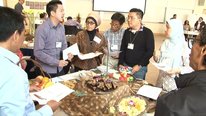- Barbara Rogoff
- http://people.ucsc.edu/~brogoff/
- UCSC Foundation Professor of Psychology
- Learning through Observing and Pitching In to Community Activities
- http://www.learningbyobservingandpitchingin.com
- University of California, Santa Cruz, California State University
- Maricela Correa-Chávez
- Assistant Professor
- Learning through Observing and Pitching In to Community Activities
- http://www.learningbyobservingandpitchingin.com
- California State University Long Beach, University of California, Santa Cruz
Public
Choice
Choice
Public Discussion
Continue the discussion of this presentation on the Multiplex. Go to Multiplex








Colleen Lewis
Assistant Professor
Fascinating work! Thanks for sharing!
I’d love to hear how you think about this work as disrupting hierarchical narratives of intelligence?
Barbara Rogoff
UCSC Foundation Professor of Psychology
The keen attention of Mayan and Mexican-heritage children points to the importance of understanding the different strengths that children bring to their learning.
Robert LeVine
Dear Barbara, Well done! You have once again, as with “guided participation”, hit the nail on the head, identifying and conceptualizing what anyone can see but might not notice. This deserves wide publication. Best, Bob
Barbara Rogoff
UCSC Foundation Professor of Psychology
Thanks, Bob! My research team, and especially I, owe you a great debt of gratitude for your leadership in this line of work! Barbara
José Cahun
K’am ki’imak óolal Xbarbara Rogoff , jach máan uts a meyaj. táan in xokik a ts’íib / Congratulation, greetings from Jo’ Tsuk ( Tihosuco) Quinatana Roo. I like your work, I hope someday you could do some investigation about yucatecs mayan.
Barbara Rogoff
UCSC Foundation Professor of Psychology
From the perspective of middle-class teachers, the keen attention of Indigenous and Mexican-heritage children might not be noticed as a strength. Or it might even be misinterpreted as distraction when children notice what is going on around them, when in fact it is very skilled attention and learning.
Jean Ryoo
I love how you are highlighting the strengths that children can bring to their learning experiences. Thank you for pushing people to think about the different ways that children learn, interact, and engage that can be utilized as assets toward new learning, rather than approached as “problems” in educational contexts.
Barbara Rogoff
UCSC Foundation Professor of Psychology
Yes, building on children’s strenghs can bring about a paradigm shift in how learning situations are organized — especially for children who have been poorly served by schools so far.
Barry Fishman
Professor
In the video, the narrator says that “Guatemalan/Mayan children were twice as likely to pay attention to a nearby demonstration…” and I presume this comparison is to the “European/American” children in the next scene. The video doesn’t ponder reasons for this. Now that you have observed this pattern, do you have theories about what drives these differences?
Barbara Rogoff
UCSC Foundation Professor of Psychology
The pattern of differences in children’s learning from surrounding events fits a paradigm that we call “Learning by Observing and Pitching In”(LOPI). Keen attention is part of one of the 7 defining features of the LOPI approach. Another defining feature is that children are included as collaborating contributors to family and community endeavors. If you’d like to know more about LOPI, please ask more questions. Or, you can see more about it at www.learningbyobservingandpitchingin.com
Tamara Moore
This is really interesting work. Are you to the point where you have implications for classrooms in the US? If so, can you please include them? As a curriculum designer, these would be very helpful.
Barbara Rogoff
UCSC Foundation Professor of Psychology
Thanks! The findings that Indigenous- and Mexican-heritage children are especially keen observers lead to several implications for classrooms:
1. Teachers who are aware of cultural differences in learning by observing could build on it for more effective teaching and learning.
2. Curriculum could be designed more openly for children to observe each others’ and adults’ work.
3. Children whose family life does not prepare them so well for learning from surrounding events could learn from children from backgrounds where this is prioritized.
Cullen White
Director
I agree that this is very fascinating work. I’m curious though: were observations of Mexican-heritage and indigenous children made in Guatemala, Mexico, the US, or a mixture of all three?
Barbara Rogoff
UCSC Foundation Professor of Psychology
These studies have been done in a Mayan community in Guatemala and in Mexican- and European-heritage communities in the United States. We’ve also done a number of studies in Mexico on related themes (especially, children’s collaborative initiative). Several related studies were published in 2014 in the journal Human Development and in 2015 in Vol. 49 of Advances in Child Health and Behavior.
Leslie Lopez
Thank you for sharing your findings!
I have also advocated that teachers become more keenly sensitized to children from indigenous/oral culture backgrounds in order to understand the social-emotional alienation (loneliness) they may experience when expected to suddenly individuate into text-mediated worlds in school, often an implicit expectation aggravated by language barriers. I generally hear people attribute exclusion and barriers solely to language; it is rare that researchers take orality/literacy and culturally distinct ways of communicating and mediating the ZPD into account. Do any aspects of your work address the oral/text interface and learning and teaching strategies across cultures?These correlate with what I have also seen; and I believe they are at least partly explained by differences in strongly oral cultures vs. strongly visual text/mediated cultures (aggravated in the US context by technology and overwork that separates and individuates people and splits families.
Barbara Rogoff
UCSC Foundation Professor of Psychology
We do find systematic differences based on extent of Western schooling, in European-American families and also within Mexican-heritage and Indigenous populations. Children from families with extensive experience of Western schooling tend to use a narrower focus of attention. This is encouraged by their teachers as well as their parents. Paradise et al wrote about the attempts to control and narrow children’s attention among teachers, in the article “One-two-three, eyes on me! Adults attempting to control versus guiding in support of initiative,” which appears in the journal Human Development (2014).
David Leach
I know this was designed as a brief overview video, but I would guess there’s a whole lot of underlying research you’ve done that identifies reasons behind these findings, such as your Learning by Observing and Pitching In research. From experience and observation, this is a technique not often practiced in North American households, where children are largely segregated from adults most of the time. Even in our classrooms, we put kids all of the same age in a classroom and then subject them to instruction on subjects, without directly encouraging their input into the curriculum or methodology of instruction. Then we wonder why our kids don’t care about school and lack basic skills in arts, handiwork, home craft and other areas requiring craftsmanship and design understanding. But they can throw a ball and play video games well. It’s a fascinating journey we’re on. Thanks for doing this research.
Barbara Rogoff
UCSC Foundation Professor of Psychology
Your observations are right on the mark! Our research suggests that the segregation of middle-class children from community life, and removing their opportunities to contribute, are an important part of the explanation for their lower attentiveness to surrounding events. And their lower level of collaborative initiative.
Teresa Eastburn
Your research always fascinates me, Barbara. I meet you back in the early 2000s when you spoke with CILS participants at the Exploratorium. I’ve followed your work ever since. Thanks so much for your wealth of research on important developmental questions across cultures!
Barbara Rogoff
UCSC Foundation Professor of Psychology
Thanks! I hold out hope that the model of informal learning provided by Indigenous-heritage communities of the Americas can help shape learning in institutions like science centers and schools!
Leslie Herrenkohl
Hi Barbara. This is such important work that builds on your longstanding findings about the cultural nature of human development. I really appreciate how the video positions Mayan children’s attention as the normative center. We know that sharing attention is one of the critical aspects of early learning for all children. Have you found that Mayan infants and very young children show different abilities in this regard as well or is it just as they get older that we see this different emerge? It is critical that we come to see children’s cultural practices as resources and that we learn to identify the different resources that children bring with them to organized educational opportunities in and out of school. Thank you for always pressing us to do this!
Barbara Rogoff
UCSC Foundation Professor of Psychology
We have some indications that the attentional expertise of the Mayan children is already beginning in toddlerhood, and it seems to continue developing through childhood. Mayan toddlers attended skillfully to surrounding events more so than middle class European-American toddlers (and their mothers!). In both backgrounds, it appears that skilled attention to surrounding events continues to develop to adulthood. (Mothers in both communities attended more skillfully to surrounding events than did their toddlers.) This was reported in our 1993 SRCD Monograph, and has been followed up in several subsequent studies in the same communities as well as in Mexican-heritage communities in the US.
The Indigenous and Mexican-heritage pattern seems to relate to the collaborative, inclusive approach of those families and communities. Yes, there’s something important here.
Diane Rodriguez
Thank you for sharing such important findings. My son watched the video and felt proud of his Mayan background.
Barbara Rogoff
UCSC Foundation Professor of Psychology
Wow! That means so much to us! Thank you!
Francisco Vazquez
I wonder to what extent socio-economic factors enter into the explanation. For example, in indigenous communities survival depends on careful observation and quick learning of the tasks at hand. There are serious consequences for those who are unable to to that. In European-descent, middle class families, there are no equivalent serious consequences.
I would be curious to learn what the test would be like with middle class Mexican and Guagemalan indigenous children.
At any rate, thank you for your contributions to this field of study and to my compadre Roberto Estrada for sending me your information.
Barbara Rogoff
UCSC Foundation Professor of Psychology
Well, the way I look at it, culture includes socioeconomic circumstances. The constraints and opportunities that are common in any cultural community involve not only values and practices but also their place in historical events and global economics and local sources of sustenance and the spread of Western schooling.
With Mexican-heritage children in the US whose families have extensive Western schooling, their attention looked more like that of middle-class European-American children — not as attentive as Indigenous-heritage children from Mexico and Guatemala. Guatemalan Mayan children from families with extensive Western schooling were intermediate in attention between the Guatemalan Mayan children from more traditional families and European American middle-class children.
I would emphasize the children’s and parents’ experience in the attentional practices favored in Western schooling (‘all eyes on me’), which is a part of what we call middle-class.
Please say hi to my buddy Roberto.
Jennifer Adams
Thanks Barbara for this powerful research that demonstrates the learning strengths embedded in cultural interactions that are often overlooked in the context of Western, Eurocentric schooling. As one person mentioned above, this also speaks to the separation of children from adult life that often occurs in middle class families here in the US. Any thoughts about the implications for this beyond learning at the childhood level, do adults in learning contexts in cultures that you researched learn in similar ways?
Barbara Rogoff
UCSC Foundation Professor of Psychology
We’ve done a couple of studies of adults’ (mostly mothers’) attention in the same Mayan community. They were very alert to surrounding events, skillfully staying on top of several competing events at the same time. Even more so than the children. The widespread attentional skills fits with cultural values emphasizing being alert and helpful.
Further posting is closed as the showcase has ended.